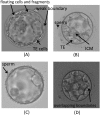A review on automatic analysis of human embryo microscope images
- PMID: 21379391
- PMCID: PMC3044885
- DOI: 10.2174/1874120701004010170
A review on automatic analysis of human embryo microscope images
Abstract
Over the last 30 years the process of in vitro fertilisation (IVF) has evolved considerably, yet the efficiency of this treatment remains relatively poor. The principal challenge faced by doctors and embryologists is the identification of the embryo with the greatest potential for producing a child. Current methods of embryo viability assessment provide only a rough guide to potential. In order to improve the odds of a successful pregnancy it is typical to transfer more than one embryo to the uterus. However, this often results in multiple pregnancies (twins, triplets, etc), which are associated with significantly elevated risks of serious complications. If embryo viability could be assessed more accurately, it would be possible to transfer fewer embryos without negatively impacting IVF pregnancy rates. In order to assist with the identification of viable embryos, several scoring systems based on morphological criteria have been developed. However, these mostly rely on a subjective visual analysis. Automated assessment of morphological features offers the possibility of more accurate quantification of key embryo characteristics and elimination of inter- and intra-observer variation. In this paper, we describe the main embryo scoring systems currently in use and review related works on embryo image analysis that could lead to an automatic and precise grading of embryo quality. We summarise achievements, discuss challenges ahead, and point to some possible future directions in this research field.
Keywords: embryo grading; image analysis; in vitro fertilisation..
Figures
References
-
- "2006 Assisted reproductive technology success rates: national summary and fertility clinic report".[Online] Available:www.cdc.gov/ART/ART2006/508PDF/2006ART.pdf . 2006. [23 March 2009]. - PubMed
-
- "SART, Society for Assisted Reproductive Technology". [Online] Available: http://www.sart.org . [23 March 2009].
-
- Crosignani PG. (ESHRE Capri Workshop Group), "Multiple gestation pregnancy". Hum. Reprod. 2000;15:1856–1864. - PubMed
-
- Petterson B, Stanley F, Henderson D. " Cerebral palsy in multiple births in Western Australia". Am. J. Med. Genet. 1990;37:346–351. - PubMed
LinkOut - more resources
Full Text Sources
Other Literature Sources


